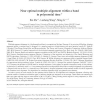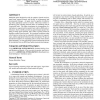1040 search results - page 202 / 208 » Tools for modeling and solving search problems |
GECCO
2010
Springer
13 years 9 months ago
2010
Springer
This paper takes an economic approach to derive an evolutionary learning model based entirely on the endogenous employment of genetic operators in the service of self-interested a...
IPM
2008
13 years 8 months ago
2008
Many machine learning technologies such as support vector machines, boosting, and neural networks have been applied to the ranking problem in information retrieval. However, since...
STOC
2000
ACM
14 years 1 months ago
2000
ACM
Multiple sequence alignment is a fundamental problem in computational biology. Because of its notorious difficulties, aligning sequences within a constant band (c-diagonal) is a ...
ATAL
2008
Springer
13 years 10 months ago
2008
Springer
Intelligent agents designed to work in complex, dynamic environments must respond robustly and flexibly to environmental and circumstantial changes. An agent must be capable of de...
JIRS
2000
13 years 8 months ago
2000
Agents (hardware or software) that act autonomously in an environment have to be able to integrate three basic behaviors: planning, execution, and learning. This integration is man...


